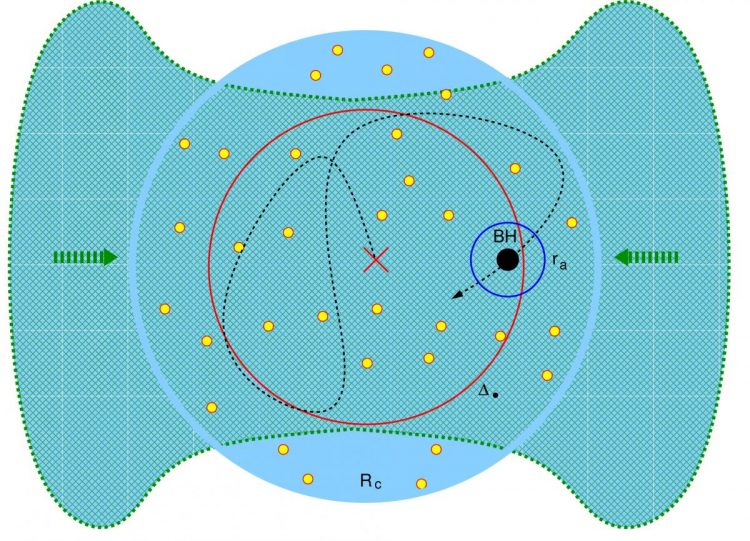All-You-Can-Eat at the End of the Universe

A small black hole gains mass: Dense cold gas (green) flows toward the center of a stellar cluster (red cross in blue circle) with stars (yellow); the erratic path of the black hole through the gas (black line) is randomized by the surrounding stars
At the ends of the Universe there are black holes with masses equaling billions of our sun. These giant bodies – quasars – feed on interstellar gas, swallowing large quantities of it non-stop.
Thus they reveal their existence: The light that is emitted by the gas as it is sucked in and crushed by the black hole's gravity travels for eons across the Universe until it reaches our telescopes.
Looking at the edges of the Universe is therefore looking into the past. These far-off, ancient quasars appear to us in their “baby photos” taken less than a billion years after the Big Bang: monstrous infants in a young Universe.
Normally, a black hole forms when a massive star, weighing tens of solar masses, explodes after its nuclear fuel is spent. Without the nuclear furnace at its core pushing against gravity, the star collapses: Much of the material is flung outwards in a great supernova blast, while the rest falls inward, forming a black hole of only about 10 solar masses.
Since these ancient quasars were first discovered, scientists have wondered what process could lead a small black hole to gorge and fatten to such an extent, so soon after the Big Bang.
In fact, several processes tend to limit how fast a black hole can grow. For example, the gas normally does not fall directly into the black hole, but gets sidetracked into a slowly spiraling flow, trickling in drop by drop. When the gas is finally swallowed by the black hole, the light it emits pushes out against the gas. That light counterbalances gravity, and it slows the flow that feeds the black hole.
So how, indeed, did these ancient quasars grow? Prof. Tal Alexander, Head of the Particle Physics and Astrophysics Department, proposes a solution in a paper written together with Prof. Priyamvada Natarajan of Yale University, which recently appeared in Science.
Their model begins with the formation of a small black hole in the very early Universe. At that time, cosmologists believe, gas streams were cold, dense, and contained much larger amounts of material than the thin gas streams we see in today’s cosmos. The hungry, newborn black hole moved around, changing direction all the time as it was knocked about by other baby stars in its vicinity.
By quickly zigzagging, the black hole continually swept up more and more of the gas into its orbit, pulling the gas directly into it so fast, the gas could not settle into a slow, spiraling motion. The bigger the black hole got, the faster it ate; this growth rate, explains Alexander, rises faster than exponentially.
After around 10 million years – a blink of an eye in cosmic time – the black hole would have filled out to around 10,000 solar masses. From then, the colossal growth rate would have slowed to a somewhat more leisurely pace, but the black hole’s future path would already be set – leading it to eventually weigh in at a billion solar masses or more.
Prof. Tal Alexander’s research is supported by the European Research Council.
Media Contact
All latest news from the category: Physics and Astronomy
This area deals with the fundamental laws and building blocks of nature and how they interact, the properties and the behavior of matter, and research into space and time and their structures.
innovations-report provides in-depth reports and articles on subjects such as astrophysics, laser technologies, nuclear, quantum, particle and solid-state physics, nanotechnologies, planetary research and findings (Mars, Venus) and developments related to the Hubble Telescope.
Newest articles

“Nanostitches” enable lighter and tougher composite materials
In research that may lead to next-generation airplanes and spacecraft, MIT engineers used carbon nanotubes to prevent cracking in multilayered composites. To save on fuel and reduce aircraft emissions, engineers…

Trash to treasure
Researchers turn metal waste into catalyst for hydrogen. Scientists have found a way to transform metal waste into a highly efficient catalyst to make hydrogen from water, a discovery that…

Real-time detection of infectious disease viruses
… by searching for molecular fingerprinting. A research team consisting of Professor Kyoung-Duck Park and Taeyoung Moon and Huitae Joo, PhD candidates, from the Department of Physics at Pohang University…





















